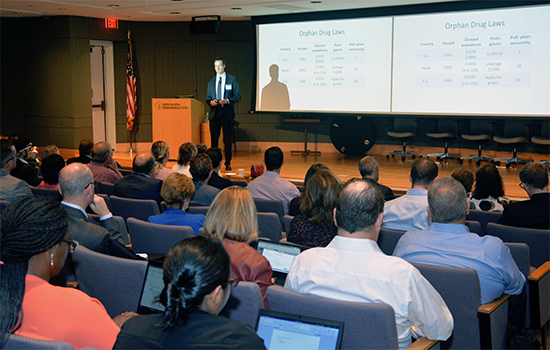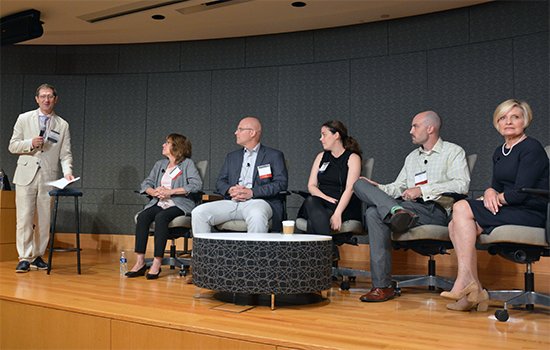
Rare Disease Forum Covers Regulation and Novel Strategies for Accelerating Cures

Priority Review Voucher Program, which he had a role in creating.
Over 120 life science professionals in the race for new therapies for rare disease gathered for a full late-September day of speakers, panels, audience engagement and networking, at the Rare Disease Forum at the North Carolina Biotechnology Center.
This was the second of the two-day Invest in Cures & Rare Disease Day Forum event, this one presented in conjunction with the UNC Catalyst for Rare Diseases at the University of North Carolina’s Eshelman School of Pharmacy. The UNC Catalyst, as the name implies, works in many areas to try to spur development of new therapies in rare disease – research of genetic mutations, work with patient organizations, training postdoctoral fellows, partnering with foundations and others in fundraising for research and operating as an open access science model.
New Ecosystem for R&D Emerging
The first session featured three speakers on the emerging ecosystem for rare disease research and development. Anthony Hickey, Ph.D., director of the UNC Catalyst, chaired.
Health economist David Ridley, Ph.D., lead author on the publication that led to passage of the 2007 federal law creating the FDA’s Priority Review Voucher Program, described the program with examples of its impact and uses by companies over the last decade. Ridley is the Dr. and Mrs. Frank A. Riddick Professor of the Practice, The Fuqua School of Business, Duke University.
Following approval by FDA of a treatment for a neglected or rare disease, the developer receives a voucher for priority review to use for a different drug, which does not have to be for a rare or neglected disease. The voucher can be sold. Thus, a small developer, for example, can sell the voucher to another company, such as a big pharmaceutical, to use on a drug that would not otherwise qualify for priority review. The smaller company can then use proceeds from the sale to fund its ongoing R&D. Similarly, a larger company can receive a voucher for a rare disease drug FDA approves and use it to bring another with anticipated high sales to market sooner, gaining valuable first sales and market advantage.
“Investors are more willing to provide funding to entrepreneurs working on drugs for neglected diseases,” said Ridley. The voucher system has also incentivized some companies to expand their R&D to include work on therapies for neglected or rare diseases, in addition to other drugs with large sales potential.
Supply and demand determine the sales value of these vouchers, and they do not have an expiration date. Of the 31 vouchers awarded since 2009, 15 have sold at prices ranging from $68-$350 million, according to Ridley. Only three have sold for more than $200 million, with most selling for approximately $100 million.
He referred audience members to his website for additional information about other details of the program.
Sean Ekins, Ph.D., D.Sc., founder of Collaborations Pharmaceuticals, spoke about his unique approach to achieve his goal of bringing multiple therapeutics to the clinic for rare and neglected diseases. CP performs R&D and partners with academics or companies to identify and translate early preclinical to clinical-stage assets.
“I want to be the Henry Ford of rare disease,” he said, describing his efforts to scale, streamline and automate the R&D of rare disease. So, instead of working on a single therapy for a single disease, CP has a pipeline of multiple therapies targeting multiple diseases, without venture capital or angel funding. To date, CP has raised $7 million on 16 federal grants.
He then described examples of projects and methods of their work in Ebola, Chagas Disease, Pitt Hopkins Syndrome and others. This has involved the creation of collaboration networks, use of machine learning and building of Assay Central. Assay Central is a tool for building and sharing statistical models from data that leverages knowledge of previous attempts, successful and otherwise, at drug discovery that may have alternative uses or can be used with machine learning to move others’ work forward.
“It takes too long to develop treatments for these rare diseases,” Ekins said. “We have to make this process more efficient, and what it really lacks is funding.”
CP now has four Orphan Drug designations and is trying to get Priority Review vouchers for as many as they can, and then reinvest funds from the sale of them into continued work in rare disease.
Kathleen Miller, Ph.D., economist in the Office of Orphan Products Development (OOPD) at FDA, next spoke about rare disease drug regulation. The OOPD administers designation and grant programs.
Designations include as an Orphan Drug, a Rare Pediatric Disease (part of the rare pediatric disease priority review voucher program) and as a Humanitarian Use Device. In 2018, according to Miller, FDA received 507 new requests for Orphan Drug Designation and granted over 300, 90 of which ultimately received approval. Not every drug designated gets approved, she said.
It’s grant programs are the $15 million Clinical Trials Grant Program, the $6 million Pediatric Device Consortia Grant Program and the $2 million Natural History Grant Program.
Finally, she detailed the drug approval process and programs for expediting novel drug approvals, including Priority Review, Fast Track, Accelerated Approval and Breakthrough Therapy designations. More information is available on the OOPD website.
Barriers to Rapid Development and Delivery
Collaborations Pharmaceuticals’ Sean Ekins returned to moderate a panel of representatives from two disease foundations, two drug development companies and FDA’s Miller for a discussion of the barriers to rapid development and delivery of therapeutics in rare disease.

Fred Porter, Ph.D., Katie Miller, Ph.D., Andy Holt and Sharon King
on barriers to rapid development and delivery of therapeutics.
Sharon King, founder of Taylor’s Tale, an organization named for her daughter who died from CLN1, described the effort to gain passage of the state law creating the NC Rare Disease Council, which she said is the first of its kind in the nation.
“I became the mother raging against rare disease,” said King about her advocacy work.
Andy Holt, vice president of business development and manufacturing support at Asklepios BioPharmaceuticals, the rapidly growing company created to advance the pioneering gene therapy work of Jude Samulski, said his company’s biggest challenge is prioritizing projects. A year and a half ago, he said, he was employee number 18 and the roster now has 65-70.
“The worst thing we could do is overpromise,” said Holt, “So communication is critical.”
Joan Levy, director of research at the Chordoma Foundation, said there are no systemic treatments approved for Chordoma, a rare cancer of the bones, skull base and spine, only surgical excision. She said her foundation is working with Collaboration Pharmaceuticals to repurpose a drug for another indication and to target a protein that has been deemed “undruggable.” She said a key barrier to development is identification of patients for research.
FDA’s Kathleen Miller said a barrier to development is often good understanding of the natural history of rare diseases – their genetic basis, the many mutations and then understanding what will be effective. Holt added that raising awareness through forums such as these around the country would be helpful, because to get the best natural history study, they may have to go to Iowa or Sweden for a patient population in rare disease.
Finally, Fred Porter, Ph.D., senior vice president of technical development and manufacturing of gene therapy at BridgeBio, explained that his company is a development company, not a discovery company. It relies on academic partners, so finding good partners is critical. As the company name implies, it tries to bridge from genetic scientific discoveries to develop with speed and scale therapies for unmet medical needs.
Complementary Strategies Improve Outcomes
The final session, chaired by Alex Tropsha, Ph.D., director of the UNC/NC State Rare Disease InfoHub, a portal for sharing information and open access to data in rare disease, featured three speakers using complementary strategies to improve outcomes.
Lisa Gehtland, M.D., public health analyst and physician with RTI International, spoke about screening healthy newborns for rare disease. She noted some of the challenges in doing so and that each state, not the federal government, decides what is on the newborn screening panel. Adding to the state’s panels is also difficult because each has a different review process that is often slow.
“Rare diseases are caught in a Catch-22,” she said. “You can’t get screening without data [to justify its need] and can’t get data without population screening.”
RTI has built a program called Early Check. It is a research study that recruits mothers to consent to extra tests for newborn screening, without an additional needle stick, for fragile x syndrome and spinal muscular atrophy.
Jim Hagood, M.D., a pediatric pulmonologist and director of the UNC Program for Rare and Interstitial Lung Disease, explained that work in rare disease often provides clues to understand normal health. He shared success stories about the dramatic change in life expectancy in cystic fibrosis with the advent of medications and how a new medication changed the landscape of spinal muscular atrophy, which is not a lung disease, but the life-shortening component, he said, is respiratory compromise.
Finally, Rada Chirkova, Ph.D., professor of computer science, NC State University, engaged the audience in a demonstration of the UNC/NC State Rare Disease InfoHub and invited input on its design and content. She characterized the InfoHub as at the juxtaposition of major North Carolina priorities – the 2015 passage of the state law establishing the Advisory Council for Rare Diseases and the state’s acknowledgement of the importance of data science for its economic development.
She described the many efforts to collaborate through the UNC Catalyst for Rare Diseases and to compile information from the Carolina Data Warehouse at UNC, multiple academic research groups and a growing number of North Carolina companies working in rare disease.
The InfoHub is the first of a three-part project that also includes development of a portal to assist clinicians in the diagnosis of rare disease and a portal to facilitate R&D of rare disease treatments.
